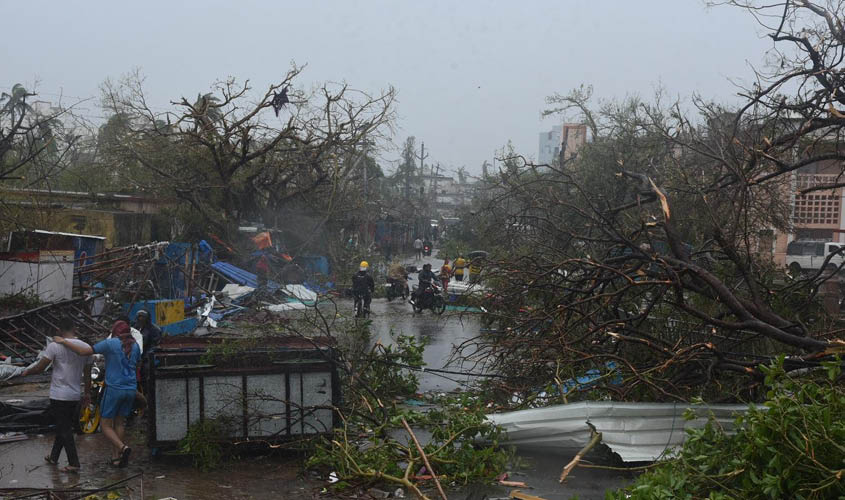Real Time Governance Society office applauded for averting loss of lives.
Hyderabad: At around 1.30 pm on Friday, when super-cyclone Fani crossed the coast near temple town Puri in Odisha with heavy rainfall and winds at speeds of over 100 kmph, there was a sort of celebration at the Real Time Governance Society (RTGS) office in Vijayawada in Andhra Pradesh as officials and the staff over there were receiving compliments from all over the world, for averting a big loss of lives in the calamity.
Of course, there is a big loss of cattle, crops, houses and other assets due to the super-cyclone, but that damage can be repaired over a period of time. So far, the Centre has released Rs 1,000 crore for relief measures to both Odisha and Andhra Pradesh. Fani’s rated as a furious cyclone, on the lines of the one that hit Odisha in 1999, which claimed around 1,000 lives in Puri and Paradeep port.
Odisha, which bore the brunt of Fani fury since Thursday midnight, sent a big thanks message to RTGS for helping it to almost minimise the loss of lives, thanks to the precise cyclone tracking information given by it for the last three days. Odisha Chief Minister Naveen Patnaik sent a message, saying that the RTGS played a role in evacuating around eight lakh people from cyclone-prone areas. Only two deaths have been reported so far.
The Union Ministry of Railways, too, thanked RTGS for providing information on the course of Fani’s progress for the last 24 hours so that they could take precautionary measures along the east coast. The railways have cancelled around 160 train services since Thursday early hours. Advanced information on train services cancellation from Bengal to Andhra Pradesh prevented people coming out on the day Fani crossed the coast.
In Andhra Pradesh, for which RTGS has kept an eye on Fani’s course since 28-29 April, there has been no loss of life and around two lakh people from low-lying areas to cyclone shelters. The usual drill of cyclone preparedness that has been practiced in Andhra Pradesh for the last two decades has helped achieve this, but actual data on the storm path made the job easier for officials involved in relief operations.
This is the second time in the last five months that the RTGS’ information has averted a big loss of lives in super cyclones—when the wind speed crosses 100 kmph. On 17 December 2018, too, the government sponsored society won compliments from the state and Central governments for providing precise data that prevented the loss of lives in Pethai cyclone. Another storm, Titli, came later, but it was not a super-cyclone.
The Odisha government shifted around eight lakh people to around 3,000 centers—cyclone shelters, schools and government buildings since Thursday and arranged food and water to people. Apart from that, the state government alerted the public not to venture into sea, come on to the streets and declared a holiday for schools on Friday. The same drill was followed in Andhra Pradesh too.
The Central’s Indian Meteorological Department (IMD), too, played a major role in providing cyclone related information to the states, but the quality of data supplied by RTGS was different and precise, said officials from the Andhra Pradesh government. RTGS has issued alerts like the storm might bit Visakhapatnam between 5 am and 7 am with winds at 120 kmph.
The alerts from IMD were broad in nature and gave vast range of areas. Both Andhra Pradesh and Odisha governments stopped bus services and discouraged private transport on the roads that come under the path of Fani. Andhra officials were used to specific information on cyclone course, but for Orissa officials it was a first time experience. The cyclone relief operations were also helped by the Election Commission’s (EC) decision to suspend the Model Code of Conduct (MCC) in the affected districts for relief operations. Both Naveen Patnaik and Chandrababu Naidu had written to the EC early this week, seeking exemption from MCC for cyclone relief work.
Around 900 teams of the National Disaster Response Force (NDRF) swung into action in Odisha since Friday afternoon to clear roads and restore power supply along the coastal belt.
“Thousands of trees were uprooted and electrical poles too fell down. Many culverts collapsed and rivers are in spate; it may take a couple of days to restore power supply,” said an NDRF official in Visakhapatnam.
RTGS CEO and senior IAS officer A. Babu told this newspaper on Friday that the two year old real-time control room has gathered cyclone related data from over 50 sources from all over and processed it to suit the needs of local officials. Around 18,000 government officials were pressed into service to see that there was no massive damage to human life and standing crops.
“This way, we have reached the cyclone management capabilities of the US and other developed nations,” an official of Andhra Pradesh’s disaster management department said.

